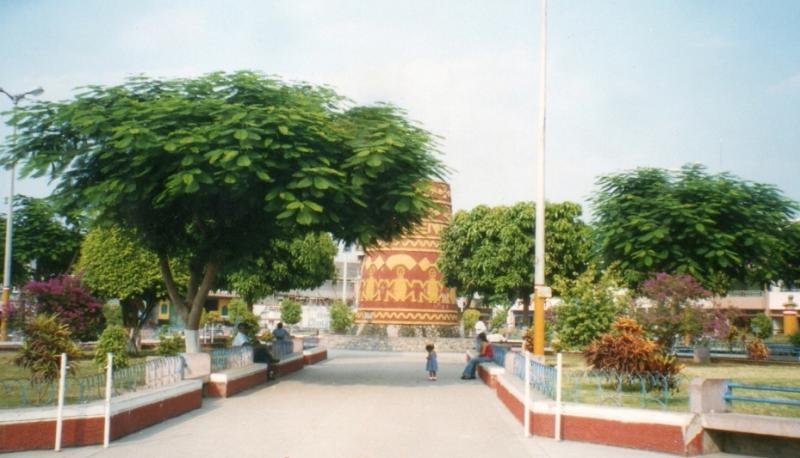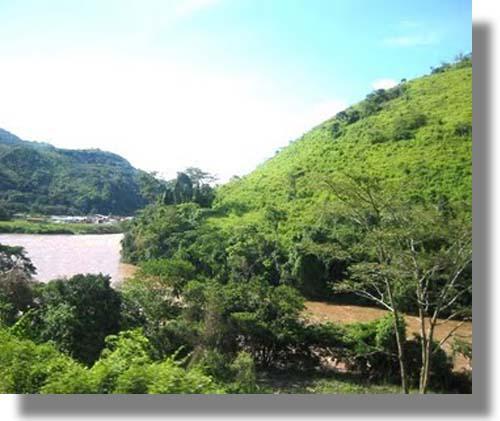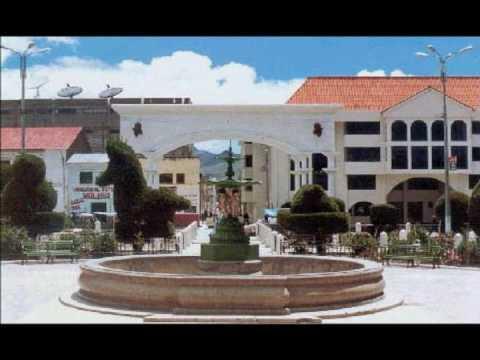Yunguyo, Puno, Peru
Suggest Place to Visit
1284
Track to location with GPS |
 |
The archaeological remains of ceramics, which were found inside
the city of Yunguyo, for its decoration, color and shape, belonging to the Inca period. In architecture there is a large corner of tall stones, which are found in private houses,
as well as the Temple of Our Lady of the Assumption, which is the main door, in a very beautiful interior, with high stones in a line with flint, with the appearance of gray granite material, dices of rectangular cubic shape and of different sizes, forming the rows
from the base to the lintel of the door on both sides; the dimensions of the tall stones are 105x55x50 cm, 95x58x24cm, 152x37cm, as well as in the construction of the tower
It seems that these tall stones are the remains of the temple of the sun, the Inca palace and other environments, which were built in Yunguyo or in the place Milagro (near Kasani), in metallurgy tumors, tupus, bands and plates have also been found bronze, which corresponds to the incan. A well known tradition, that the name of Yunguyo comes from the Aymara word Yunga Uyu the bed of the Yungas; you decide, in ancient times it was a place where travelers from the Yungas of Bolivia to Upper Peru stayed and rested for several days, after traveling a long distance to Cusco, later in the Inca period, making a pilgrimage to Surrender I beg to the monarch of Cusco, taking a present as a tribute.
One of the first Incas was Pachacutec, after winning the Kollas and Lupi Jak'es and after a rest in Chucuito, after Tiahuanaco, crossing the Tiquina section, I propose to visit the different islands of Titicaca, of importance. of the natives, went to the Sacred Islands to honor his huaca, at the same time
A temple dedicated to the Sun was ordered to be built on this island, a palace for him and his descendants. His return home was Cusco, fortunately the axis that passed through Yunguyo.
The Inca Tupac Yupanqui also visited the temple of the sun that his priest had ordered built, myths of his confidence, of the royal blood as pontiffs and custodians of the Adoratory; other inhabitants of
the Island, they moved to Yunguyo, because they were not apt to moralize
and celebrate the Sun service; Asismo, established a monastery or ajllahuasí, for the virgins of the sun or Ajllas. On the Isthmus of Yunguyo, there was a great Aymara wall from coast to coast (Wiñaymarca and Titicaca), with guards and guardians, who marked the beginning of the sacred temple; the pilgrims who came from lions like Quito, Pasto, Chile, etc., first went to confessing priests like Aucachic who resided in Yunguyo for the act of penance and the purification ceremony; the Aucachic imposed as penance, striking with an extended hair and depriving himself of salt, meat and meat, for all the pilgrims, including the Inca. This Inca mixture was built by a great Colca, in Yunguyo, to store food, drinks, clothing, meat, etc., for the sustenance of visitors, chasquis and the army, in the same way the Ccorpohuasis also lived, to house the pilgrims and other people. In many writings reference is made to one of the Incas opening a channel to unite Lake Titicaca and Wiñaymarca in this isthmus of the Yunguyo, a work that has not been completed. In this way Yunguyo was the first pilgrimage and purification station, from which several days passed. The Inca Huayna Cápac, following the example of Father Tupac Yupanqui, after the preparations in Yunguyo as he used to do, entered the temple of the sun and also founded another temple dedicated to the Moon Goddess in the, Isla Coati and Isla Coya and and the Ajllahuasi
I left one of your children. After the death of Inca Huayna Cápac, between the years 1525 to 1527, the indisputable successor was Inca Huáscar, in the axis of the alleged division of the empire like other affirmative chroniclers; when he ruled Huáscar in 1525, the rebellion of his brother Atahuallpa broke out that lasted until 1532; Huáscar was defeated, held in prison and in secret; For the civil war, Copacaba and Yunguyo contributed a contingent of troops in favor of Huáscar, led by their relative Apuchallco who lives in Copacabana.
The Town of Yunguyo seems to have been founded by the Inca Tupac Yupanqui, upon his return to Cusco, from where he spent time, after visiting Titicaca Island, the natural characteristics of the island and the transfer. Yunguyo, because they were not the most moral in the most apparent to their intentions, putting them to their relatives and people from Cusco and its towns like Mitmac. To install Tupac Yupanqui to the natural islands of Yunguyo, they ordered to form a town with its temple of the sun, a palace for the Incas, like the place in Ayaviri, Chucuito capital of the Lupakas who used to be rebels, the many inhabitants won. bloody battles. Fray MARIA ELIAS, as we say in the clear statement: they were expelled from Titicaca at their destination as soon as they settled in Yunguyo. The Isthmus of Yunguyo was very apparent because it was empty and the place was unoccupied, it was only used for agricultural work and pascana or
rest of the travelers who come from the Yungas of Bolivia and vice versa. From the earliest days, Qaluyo, Pukara, Tiwanaku
who were great travelers besides showing us the true ways of Qpaq Ñan, Yunguyo casually relaxed just outside a fence around where to travel. The Inca Tupac Yupanqui institutions build a temple of the Sun, an Inca palace, other enclosures for the priest and governors, dividing in the Masaya and Arasaya barracks, called Yunka Uyo Marka, resting in the town of the Yunkas, as in the demonstrated . Archaeological evidence of the city, both in architecture and in ceramics and other remains. Yunguyo was convinced in the sacred city of the Incas from the moment that Pachacutec and Tupac Yupanqui stepped on the foundations in the village, because everything he touches, everything he touches and the place where the overnight stays become sacred. Because the great roads that go to four cities and the road that comes from Cusco to Collasuyo and that passes through Yunguyo are called Qapaq Ñan the royal road, they are also sacred. When visiting Inca Huayna Cápac on the island of Titicaca temple of the Sun, to found the Temple of the Moon on the island of Coatí, Yunguyo was a sacred city, after resting in Incaqamaña, in the Queñuani sector, (Tradition of Inca Qamaña) , entrance to the Yunguyo village, for someone to help, confession and do penance, it is said that there was a year between the island of Coati, Copacabana and Yunguyo, rooted in the palaces that existed in these places, such as the palace. from the current community of Cusijata, a few kilometers
North of Copacabana (S, Chávez 2007). RAMOS, inform us.
The Province of Yunguyo is located in the ITSMO of the name, between the TITICACA - WIÑAYMARCA lakes, southeast part of the Puno Region; Republic of Peru in the high Andean area called plateau plateau, area of influence of Titicaca, navigable lake in the high world.
As we begin this century, the peoples of the current province of Yunguyo began to decisively manage their recognition of the political category. As in 1926 it was confirmed by Law N ° 5515 as Yunguyo District, later Unicachi was elevated to the category of Anapia District, it was created by Law N ° 23606 of June 1, 1983; The Ollaraya district was created by Law No. 24019 of closed December 7, 1984; and later the Province of Yunguyo together with the districts The Districts of Copani, Cuturapi, Tinicachi were created by Law N ° 24042 of December 28, 1984
ARCHAEOLOGICAL REMAINS
Preform monolith of the Kasani neighborhood
This Charango-shaped stone is located in the Ti´racachi sector, kasani neighborhood, on the border with Bolivia. how we see that the study is missing and why these stones are in this place and what objective they fulfilled.
Monolith Kasani Quarter
This stone is located in the Kalasasaya sector near the border with Bolivia. how we see that the study is missing and why these stones are in this place and what objective they fulfilled.
The Arch of the Kasani Neighborhood - Yunguyo
This arch is Binational that divides them from the countries Peru and Bolivia; if we look inside the arch belongs to the Peruvian territory and where this I belongs to the Bolivian territory. High stone infrastructure.
MUSEO ECO ARQUEOLÓGICO YUNGUYO (Jr. Alfonso Ugarte N ° 479 Yunguyo)
Yunguyo Square of Dos Mayo
The Historic Plaza de Dos Mayo in the Yunguyo district, which is the monument of three people (Mother, Father and Son), with typical clothing of the area identified with agriculture since Inca times. The design of the monument area is detailed by metal dikes, explaining the process of Inca agriculture. so the people of this land; He usually comes to work in agriculture.
Yunguyo Main Square
The Historic District Plaza de Armas del Yunguyo, located with its attractive forms of animal figures; The background is in the Catholic Church and in front of the Municipality, because all foreign and national tourists pass through here.
Comments
We don´t have yet any comments about:
Yunguyo, Capital of Aymara Culture
Yunguyo, Capital of Aymara Culture
Be the first to leave a comment as it is very important to inform other people
Outros locais a visitar
Within a radius of 20 km from:Yunguyo, Capital of Aymara Culture
Cidade de Juanjui |
| 0,4 Km |
 |
Parque Nacional do Rio Abiseo |
| 1,8 Km |
 |
Hotel reservation near Yunguyo, Capital of Aymara Culture within a radius of 20 km
No results
Why to book with Clube Net
The best prices
Our partnerships with the world´s largest operators offer research on the best market prices.
More options
At Rotas Turisticos you can book the hotel, buy the air ticket, book the transfer from the airport to the hotel and vice versa, book the local excursions, rent the car, take travel insurance and consult the places to visit and where to go.
Holiday Tips & Destinations
Hundreds of holiday destinations with all the options that allow you to easily choose the destination that best suits your dream vacation.
Clube Net
Links





